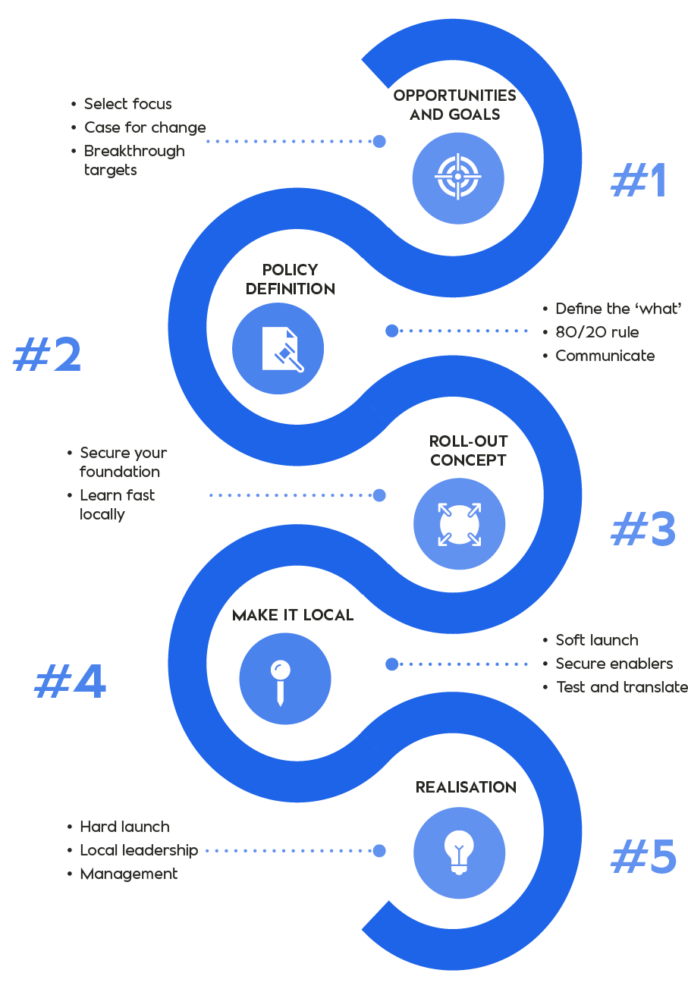Powering commercial excellence initiatives with change management thinking
In a volatile world with fast technological advances and opportunities, customer demands change and competition intensifies, putting companies’ sales effectiveness under increasing pressure. Consequently, new corporate and commercial strategies are deployed from headquarters to chart the way to growth and profitability, but they do not always provide the impact intended in the daily operations.
Improving your sales operations is about continuously developing your operating model to align people, processes, structure and technology. However, there is a distance between those who define the strategies and those who realise it that is rarely properly addressed.
“Effectiveness in our global sales organisation goes beyond just defining new concepts – it depends on changing behaviour on the ground. And this has required more than just information from us at headquarters.”
VP Commercial Excellence, Global industrial goods company
The bulk of company resources often go into defining strategies, while too little is allocated to execution. However, impact requires an integrated end-to-end process from idea to implementation with a suitable implementation cadence that allows for dealing with surprises and course corrections in the process.
Thus, in seeking to improve their sales operations globally, companies should follow five key steps. Central for all five steps is focus on change leadership as only changes in local behaviour will result in the desired impact.

#1 Select opportunities and clear goals
Select focus. Companies’ corporate or commercial strategies will typically identify areas of possibility for improving efficiency, commercial and sales performance. However, strategic initiatives are often plentiful and may not always specify what exactly drives the increased performance or what the desired impact is.
Few organisations have resources, at HQ or locally, to orchestrate several widely defined initiatives on top of daily operations, so being selective and concrete in launching initiatives is key. Moreover, a lack of clearly defined desired changes and targets often results in a lack of local execution and implementation. The local branches simply do not know what is expected of them or how to get started.
Case for change. Defining why we need to improve, what will have to change, how we expect the organisation to do it as well as KPIs for when we know we have succeeded with the commercial strategies will serve as an important ‘case for change’ to the organisation.
At the end of the day, if we do not have to change – we typically do not, so a strong case for this change is critical. Clear communication and targets from management will be the guiding star from HQ to local execution by making this a key priority in local operations and making sure focus is on activities to deliver those targets.
Breakthrough targets. In cases where companies must fundamentally transform their way of working to realise results, we often advise management to set high ambitions, or ‘breakthrough targets’ to ensure that the organisation cannot continue doing what they have always done if they are to reach the targets. At first, targets may be at a higher level, e.g. group level, but these should be translated to local or even individual levels as the implementation proceeds.
#2 Define clear policies, but prepare for localisation
Most companies define policies at a group level for how the global sales organisation should improve operations and distribute guidelines from a Centre of Excellence or another central organ.
Clearly state what needs to be done. Companies are right to define clear corporate policies for what they want done from a central hand, as this can ensure alignment with the company strategy and other central enablers such as IT, finance, etc. However, new sales transformation initiatives from the central hand often remain at a high level, so companies should ensure time and resources to detail the operational implications and formulate actual policies. These must be as concrete as possible.
Apply the 80/20 rule. Once done, companies can benefit from allowing for local involvement in defining how the policies are to be deployed. Installing new sales concepts without allowing for adjustment to local operational conditions may be difficult, as concepts will always be challenged by local exceptions. E.g. defining a worldwide set of guidelines for what size or characteristics priority customers should have will be challenged by local market structures, sizes or dynamics. Such local conditions leave guidelines difficult to comply with, and the front-line sales organisation’s motivation to change low.
Thus, in our experience, companies should instead seek to define new commercial or sales policies that are 80% decided with the most critical elements but allow for 20% localisation. The final roll-out concept can consequently be defined on these premises. They should be defined in detail at the local level so that all local employees will know exactly how to act.
Communicate. Once defined, policies should be communicated along with the case for change and clear targets to prepare the global sales organisation for the coming deployment.
#3 Plan the roll-out – three rules of thumb
Once new sales policies are defined ‘80%’, companies must define a roll-out plan and concept that takes policies beyond communication to local execution. We recommend considering three rules of thumb when planning the roll-out.
Secure your foundation. The foundation for executing policies is rarely fully ready. In planning execution, it is critical to align with the necessary enablers of future way of working (digital tools, reporting, data etc.). We therefore recommend that roll-out concepts include aligning commercial systems to support the desired behaviours in the organisation (e.g. data, measurements, processes, reporting structures, organisational structure) as these can be maintaining the old way of working if not changed.
As an example, your commercial data structure or quality may not be ready for new commercial concepts. It is therefore critical to ensure mandate, time and resources to clean, validate and structure data as part of the roll-out to drive the correct data usage and behaviour.
Learn fast – locally. Although companies have defined clear sales policies, they should design the roll-out processes to learn fast from the practical application of the policy in the local organisation.
We advise companies to plan for piloting, local co-creation and testing lead by local commercial owners to ensure a high level of applicability of the commercial concept and local anchoring from the beginning.
“Doing pilots will not slow you down, but rather pave the way for fast implementation spear-headed by early ambassadors and a strong concept.”
Corporate PMO and programme officer, Large Danish industrial goods company
Nail it before you scale it. Forget about all-at-once, roll-out initiatives. It is critical to acknowledge that the real impact will come from following through from HQ policies to actions at the local level, ensuring the full journey from idea to impact. This takes time and but also offers important learning opportunities.
As an example, we recommend choosing a narrower focus on certain regions, countries or segments when planning the roll-out and to invest in driving behavioural change and impact here, before moving on. Global scaling of a new commercial concept is easier with a ‘proof of concept’, that strengthens the case for change set presented by management.
#4 Make it local
Often, the local adaptation of a new sales policy is left to the local organisation. But just as often, they lack the resources, do not share the ambitions or have the expertise to drive the changes needed, which risks leaving new commercial policies stranded or even ignored.
Making commercial improvements stick is about translating them into local conditions and the daily lives of colleagues on the front line.
“Our corporate functions are always a great support in improving our commercial operations. But new ideas are not always applicable in our organisation, which makes it difficult to get the team behind them sometimes.”
Regional Director, Global industrial goods company
Teams in the front line need to know and understand what to change, driving a need to explicitly define the desired future state/behaviours in understandable language.
Thus, companies can benefit from investing resources in a local, three-step process that allows for testing, adjustment and implementation of new policies locally.
- Soft launch: Onboarding and introduction of policy – don’t forget the case for change.
- Ensure local enablers: Local improvement of critical enablers (e.g. data and digital tools) to ensure the applicability of new sales policy.
- Testing and translation: Once enablers are ready, ensure proper ‘translation’ of the new sales policy to fit with local conditions. This will allow for local organisations to get organised and become familiar with the new policies.
#5 Realise the desired behaviour
The final critical step is all about tying policy goals to daily behaviour.
“You have to face the fact that the corporate initiatives you implement locally are as having sand between your fingers – it disappears as soon as you let go, if you don’t manage to change the narrative from just a corporate initiative to part of daily operations.”
Head of Global Commercial programme, large Danish industrial goods company
Hard launch. Once the policy is locally adapted, policies should be written into daily operations, e.g. with firm KPIs and incentives, updated digital tools and data, SLAs, SOPs, etc. At this point, the new sales policies and concepts must be locked and gradually transform old ways of working.
Local leadership. The sales organisation in the front line must understand individual implications of a new sales policy to fully incorporate it into daily operations. Defining and communicating these implications must be done locally by the local commercial leaders to ensure a fit with local conditions. We advise to:
- Communicate the desired future: Explicitly and concretely define the desired behaviours – so they are understood in the language of the local commercial organisation
- Set individual targets: Execution plans must be broken into as precise output for the individuals in the organisation as possible, so everyone from top to bottom share the same targets – at their own level
- Offer leadership role models: Local leaders must walk the talk. Local leaders cannot expect to dictate change in their commercial teams without demonstrating the change in their own behaviour, at all levels
Maintain management focus. Executive management should keep attention on the initiative in e.g. the business reviews, from the executives’ sponsorship and local management until the commercial and local benefit is evident, and the initiative has become part of the daily operation.
At the end of the day, ensuring impact from new commercial or sales initiatives in the front line is not done overnight. It requires investment of resources and focus from central level to local level, and it may be beneficial to follow a structured process such as the one we have outlined here.
Want to know more?
Simon Bøge has formed strategies, led commercial excellence processes, and organisational and process change projects in both leadership roles in industry and as a consultant. Simon has in particular supported clients in responding to market changes, transforming their operating model, maximising commercial performance and improving financial performance through turnarounds and restructurings.
Contact Simon today to learn more about how you can achieve commercial excellence with Valcon‘s change management thinking.














